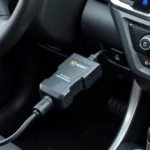Understanding the differences between Japanese Domestic Market (JDM) and United States Domestic Market (USDM) vehicles can be a challenge, especially when it comes to onboard diagnostics. One common question that arises is how to convert an OBD2 JDM car to use the OBD1 system found in older USDM models. While a complete conversion can be complex, this guide will provide you with the essential information you need to navigate the process.
Why Convert from OBD2 JDM to OBD1 USDM?
There are several reasons why enthusiasts might consider converting their OBD2 JDM car to an OBD1 USDM system:
- Compatibility with aftermarket parts: The USDM aftermarket offers a wider range of performance parts, many of which are designed to work with OBD1 systems.
- Tuning capabilities: OBD1 systems are often favored for tuning older Japanese engines due to their simpler electronics and the availability of affordable tuning solutions.
- Troubleshooting and diagnostics: Some owners find OBD1 systems easier to diagnose and troubleshoot with basic tools.
Challenges of Converting OBD2 JDM to OBD1 USDM
Converting from OBD2 JDM to OBD1 USDM is not as simple as plugging in a different connector. Several challenges need to be addressed:
- Wiring harness differences: JDM and USDM vehicles often have different wiring harnesses, even for the same model year. This means you’ll likely need to modify or replace portions of the wiring harness to ensure compatibility.
- Sensor compatibility: OBD2 systems use different sensors than OBD1 systems. For example, OBD2 vehicles typically use a wideband oxygen sensor, while OBD1 vehicles use a narrowband sensor.
- ECU compatibility: The engine control unit (ECU) is the brain of your car’s engine management system. Converting to OBD1 usually requires using an OBD1 ECU that is compatible with your engine and desired modifications.
Key Components for Conversion
Successfully converting your OBD2 JDM car to OBD1 USDM involves several key components:
- OBD1 ECU: Choosing the right ECU is crucial. Research compatible ECUs for your specific engine and consider your performance goals.
- Wiring Harness Adapter: A wiring harness adapter can simplify the process of connecting your OBD1 ECU to your JDM engine harness.
- OBD1 Distributor: OBD1 engines typically use a distributor for ignition timing. You’ll need a compatible distributor for your engine.
- Sensors: Depending on your setup, you might need to source OBD1-compatible sensors for your intake air temperature, throttle position, and other parameters.
The Conversion Process: A Simplified Overview
Converting your car’s diagnostic system is a complex task that often requires professional assistance. Here’s a general overview of the process:
- Research and Planning: Thoroughly research compatible parts, gather necessary tools, and create a detailed plan.
- ECU Installation: Install the OBD1 ECU and connect it to the engine harness using the adapter.
- Sensor Replacement: Replace any incompatible sensors with their OBD1 counterparts.
- Distributor Installation: If needed, install the OBD1 distributor and ensure proper timing.
- Wiring Modifications: Make any necessary wiring modifications to connect the new components and ensure proper communication between them.
- Testing and Tuning: Once the installation is complete, test the system thoroughly and fine-tune the ECU for optimal performance.
Seeking Professional Help
Converting from OBD2 JDM to OBD1 USDM is a challenging project that is best left to experienced mechanics specializing in JDM engine swaps and electronics. Attempting this conversion without the necessary knowledge and experience can result in damage to your vehicle or create safety hazards.
Conclusion
While converting from OBD2 JDM to OBD1 USDM can be a complex undertaking, it can be achievable with proper planning, research, and professional guidance. Carefully consider your goals, budget, and the complexity of the task before embarking on this modification. Remember, a successful conversion requires a deep understanding of both JDM and USDM automotive systems.
FAQs
1. Can I convert any OBD2 JDM car to OBD1 USDM?
Not all JDM cars are good candidates for this conversion. Compatibility depends on the specific engine, ECU, and wiring harness.
2. Is it legal to convert to an older emissions system?
Emissions regulations vary by location. Check local laws before making any modifications to your vehicle’s emissions system.
3. Where can I find reliable parts for the conversion?
Reputable JDM importers, performance parts retailers, and online forums dedicated to your car model are good places to start.
4. How much does an OBD2 JDM to OBD1 USDM conversion cost?
Costs vary depending on labor, parts, and the complexity of the conversion. Expect to spend a significant amount on this modification.
5. Will converting to OBD1 void my car’s warranty?
Yes, modifying your car’s engine management system will likely void any remaining factory warranty.
Need help finding the right OBD2 scanner for your JDM or USDM vehicle? Contact our team at WhatsApp: +1(641)206-8880, or Email: [email protected]. We offer 24/7 support and expert advice.


